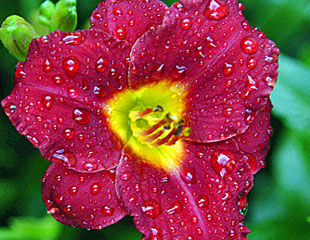
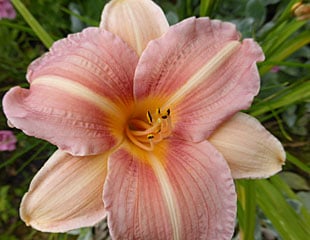
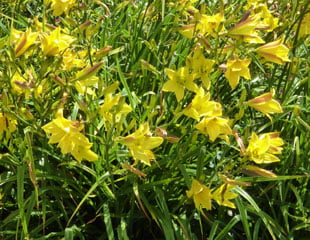
How to Grow Hemerocallis, common name Day Lily
Hemerocallis, common name Day Lily, is a summer flowering perennial plant. Each plant has multiple stems with many flower heads, ensuring constant flowers throughout the summer, even though each flower lasts for only one day. Hemerocallis comes from the Greek meaning "beautiful for a day" which also means if you want to keep the plant repeat flowering and looking attractive, regular dead-heading. As the images show, day lilies have attractive flowers and make a great addition to the border, flowering over a long period but not the best buy for your garden if you do not have time to deadhead. Because each flower lasts only a day, neglecting to remove spent blooms quickly makes the clump look untidy.
Day Lillies are fully hardy H6 which is down to - 20C (mostly) herbaceous perennials return reliably each year. Day lily vary in size from small compact varieties of around 30cms to the taller varieties of up to 1.5m. Hemerocallis is long flowering with large trumpet-shaped flowers, often with stripes and attractive clump forming foliage. Even though each individual flower is short-lived, the plant will be in flower for around 4-6 weeks.
Many Day Lilies are herbaceous, which means they die back completely in the winter, leaving bare earth and emerge in the spring with fresh growth. In milder areas, they can be evergreen or semi-evergreen.
How to plant Day Lillies

Day Lillies flower best in full sun but will tolerate partial shade. Hemerocallis is not fussy about soil types, as long as the soil is not boggy. Once established, Hemerocallis will cope with some wetter soil and have some drought resistant. Day Lilies are fully hardy, quite tough and will tolerate a range of growing conditions. The image shows Day Lilies growing in a mixed border in the NT Cotswold garden Hidcote.
The reason I have tagged Day Lillies as an amber wheelbarrow plant is although easy to grow, they require maintenance, which is dead heading.
As well, the taller, larger Day Lilies need to be staked. Although the new growth may appear very upright, don't be fooled; staking and supporting taller Day Lily varieties significantly improves their appearance. In spring, (or when you get round to it,) as the growth emerges, place a support under their foliage to keep the plant upright and stop it collapsing later in the season when there are many blooms.
In terms of maintenance, each stem has multiple flowers, which is good in the sense of making the plant attractive, but it means each flower needs to be removed to keep the plant flowering. After flowering, each stem should be cut to the ground. Once the plant has flowered and the foliage looks tatty, cut the foliage to the ground and it will reward you with fresh lush growth for the rest of the summer, although it will not flower again.
The plus side is that day lilies flower constantly from late spring to early- mid summer, with strong lush foliage and make excellent border plants. They form large clumps, see third image above right, and produce good strong colour. They look spectacular, producing large trumpet-shaped flowers in varying shades of yellow, orange, red and deepening down to crimson.
Although called a "lily" Hemerocallis is not in fact a member of the lily family, all of which are toxic to pets. Day Lilies are safe for dogs, but highly toxic for cats.
If Hemerocallis catch your eye, there are several national collections you can view. Information via the national collections site.

Day lilies are an amber wheelbarrow plant as they need some attention and division with time, so not entirely maintenance free.
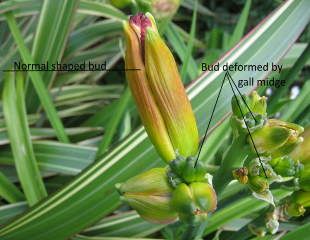
Hemerocallis gall midge
The image left a bud damaged by Contarinia quinquenotata, common name gall midge. This pest was first observed in the UK in 1989 and is now fairly widespread. Day Hemerocallis gall midge attacks Lily flowers. It is a tiny fly that lays eggs in the flower bud between May and mid-July. The larva feed on the developing flowers buds, causing buds to become deformed or not open. The fly is only active until mid-July, later flowering varieties are not affected.
Credit for this very helpful image goes to Richard Avery on Wiki. I have annotated the long unaffected bud and the cluster of shorter, deformed buds affected by the gall midge, which you can clearly see.
The larva are hard to see, being translucent. It is difficult to treat. Picking off the galls by hand is the best option, as is picking off all affected buds to try to arrest the spread.
The problem with using chemical controls is it will adversely affect visiting bees and pollinators, and not recommended.
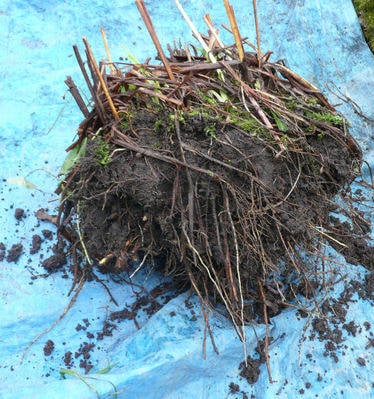
How to Divide Day Lillies
To keep Day lilies flowering at some point, usually around every three/four /five years, the plants need to be divided because they become congested. The only way to do this is to dig up the plant, divide and replant. If you have day lilies which don't seem to be flowering as well as they did, this could be the problem.
The image shows the congested clump of day lily which has been dug up and place on a tarpaulin ready for division. Divide a clump by using a small saw and cut it into pieces. Then replant, the best pieces, all of which is hard work. The time to divide is late autumn or spring.
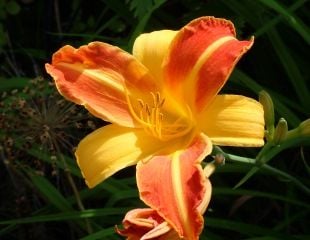
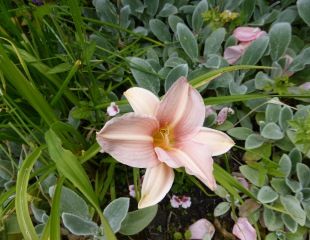
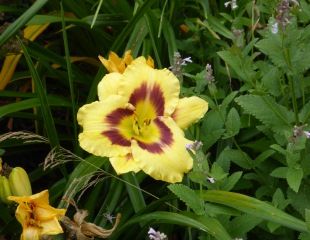
Ideas for some varieties of Day Lilies to grow
Good varieties with the RHS garden merit award are:
H. 'Marion Vaughn' lemon-yellow and 'Whichford' both are scented.
H. 'Pink Charm' has a starry shape and a salmon tinge.
H.'Gentle Shepherd' is pale pink second and centre image.
H.'Stafford' is a striking red with a yellow throat.
H. 'Elegant Candy Pretty' pink Hemerocallis with red eye and edge over green throat, and fragrant.
H 'Moonlit Masquerade' an unusual cream with dark purple.
There are dozens of varieties of Hemerocallis simple to grow in a good sunny spot.
